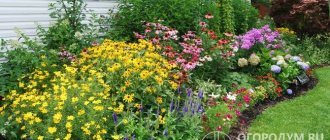What colors do phlox go with in a flower bed?
The blurry color of phlox, with large spots of other shades, creates some difficulty in matters of compatibility of these colors with others planted in the same flowerbed.
What are flowering phloxes combined with when planting in autumn? They look great near low bushes. And in the summer, geraniums, speedwells, highlanders, low-growing bells, grass carnations, and alpine asters will be an excellent addition to them.
Landscape design of flower beds
Flower beds with phlox look good together with lilies, somedago, oriental poppy, peony, lupine, campanula, and pyrethrum.
Note! In autumn they can be combined with barberry Thunberg and spirea. Planted in rock gardens, they look great with crocuses, snowdrops or scillas.
Border lilies
For decoration of borders, specimens of low and medium height are best suited, blooming for a long time and luxuriantly, with flowers blooming together. It is advisable that they all be the same color, so the border will look more impressive. You can also plant species with flowers of two contrasting colors, alternating them in a checkerboard pattern. Varieties should be selected so that the flowering process is not interrupted during the summer.
Important! The most popular border variety is the Garrisi lily. This is a good option for both small plots and spacious gardens (parks) of a large area.
Planting rules, descriptions and diagrams of flower beds
A correctly selected place for planting perennial phlox in a flower bed should not be in direct sunlight, especially at midday. This causes the petals and leaves to burn out. It is optimal to plant them close to trees or bushes to protect them from the sun and winds. It is not advisable to build such a flower bed on the north side of the site.
Flowerbed with phlox
Since varieties of this flower can be short (60 cm) or tall (up to 170 cm), they should be planted taking this fact into account. Short varieties should be planted along the perimeter of the flower bed, while for tall varieties it is better to choose a place next to the fence or in the corner of the flower arrangement. The tallest plants can be placed in the central part, and small ones along the edges.
Flowerbeds can be constructed in the following patterns:
- Multi-level flower bed. Its principle is to plant tall flowers in the center of the composition, and plants with smaller stems along the edges.
- Carpet flower bed. Its peculiarity is the selection of low-growing flowers with abundant flowering and planting as densely as possible to create the appearance of a carpet.
- Figured flower beds: heart-shaped, islands, flower-shaped. In such compositions, low-growing flowers or with medium-sized stems are used. If plants with tall stems are also used for this, they will spoil the appearance of the clubs.
- Club curb. In the territories of personal plots and gardens, paths are created that can be enlivened by a variation of the bright contours of flower plants.
Flowerbed with peonies and phlox
Peonies place increased demands on their neighbors. But peonies and phlox in the same flower bed can create an original atmosphere. The fact that peonies come in different colors allows them to be widely used in landscape design. A flower bed with peonies and phlox should be created in such a way that their height is small and does not cover the lush flowering of peonies.
Flowerbed with daylily and phlox
Daylilies are the best choice for landscaping. They can be combined with many other colors. They retain their decorative appearance until late autumn. When selecting plants adjacent to daylilies, you should carefully select their shades. For example, perennial phlox in a flowerbed with daylilies of pink and fawn shades resembles the Panikulata variety, and rich red daylilies are planted next to the Amethyst variety.
Flowerbed with daylily and phlox
Flowerbed with phlox and other plants
By following the advice on what to combine phlox with when planting, you can create flower beds that will look good at any time of the season:
Phloxes are successfully placed next to summer-autumn varieties:
For phlox that blooms in spring, you can choose the following neighbors:
They are also used for planting near borders and in rock gardens on lawns.
In order not to worry about the compatibility of shades, you can use varieties that bloom at different times in a flower garden with phlox.
These can be the following plants:
The use of irises in flower beds and pond design
Irises look very stylish and harmonious in flower beds. Other plants stand out organically against their background. The thing is that they are usually created in bluish-blue shades. This range in itself is quite unusual and rare. That is why often these shades are not enough when decorating a flower garden.
Irises look no less stylish when creating monoflowers. In this solution, it is recommended to give the landscape design element an appropriate frame. To do this, you can use backfill using gravel or natural cane.
Irises are often used to decorate ponds
Advice. As an original and harmonious addition to irises in the context of a monoflower garden, it is worth using ornamental grasses.
If there is a pond in the garden, then you should definitely use irises to decorate it. By the way, only this flower can be planted around a stream or pond. This plant goes well with water and does well in moist soil. This solution will look as natural and beautiful as possible.
The attractiveness of irises lies in the fact that they can be used to decorate the pond itself. The main thing is to choose the right variety of this flower. This solution looks non-trivial and very impressive. Accompanying plants are not required to obtain the desired picture.
Phloxes in landscape design
Since phloxes are unpretentious plants, they can be planted in a variety of places, regardless of the type of soil. Even if you don’t have a plot of land, you can plant flowers in a container. If you have land, you can give free rein to your imagination and build many flower beds with phlox.
Flowerbed with phlox
Having certain knowledge in the field of landscape design, with the help of phlox you can create various compositions that will be harmonious in color and location in space.
Note! Experts recommend planting phlox in a flowerbed in a large mass, arranging them taking into account the height of adult plants, the time of their flowering, as well as the nuances of the combination of inflorescences and foliage.
Monochromatic flowers are best suited for decorating parks and large areas, as they look most advantageous from a long distance. For those who like to enjoy the beauty of flowers in the early morning or evening, varieties with white flowers or chameleons that change color are best suited.
Care
An unpretentious plant will not be very offended if the owners do not pay much attention to it. But a little care will help the flower produce fluffy buds and delight garden owners with large flowers.
As a maintenance procedure, periodic weeding and loosening of the soil will be useful.
Faded flowers are removed immediately after they die, protruding stems and wilted leaves are trimmed. But the second point is done rather to give an aesthetic appearance to the flowerbed.
And it is worth considering that the plant will move several centimeters in each direction every year. So very soon the problem will arise, where to put the children.
Choosing a place for a flower bed
Despite the fact that phloxes are considered unpretentious and versatile plants, they will not grow in any chosen place. For fruitful cultivation, you need to take care of the appropriate soil quality and privacy.
Phloxes in landscape design
In order for phlox to feel comfortable in the garden, the following conditions must be provided:
- High-quality lighting - all phlox are light-loving crops that develop and bloom poorly in shading conditions. At the same time, different categories of plants require their own lighting intensity. Areas with diffused lighting are considered the most optimal place for growing these flowers.
- Protection from wind and drafts - otherwise the plant will lose its neatness and compactness.
As for the topography of the soil, it can be either perfectly flat or have all sorts of defects. The only thing to consider is that these flowers should not be planted in lowlands, depressions, or in places where water is likely to accumulate. As for slopes, slopes and complex terrain, phlox will be able to grow normally in such places if they are provided with the necessary conditions.
Important! When creating compositions near houses or other buildings, you need to focus directly on the objects and their impact on the microclimate. On the eastern, western and partially southern sides, it is recommended to plant bush varieties that will not grow on the northern sides.
Reproduction
Paniculate phlox can be propagated either vegetatively or by seeds.
Methods of vegetative propagation
The easiest and most popular way to propagate phlox is by dividing the bush. The level of frost resistance of this plant directly depends on its age. The younger the plant, the more frost resistance it has and vice versa. Therefore, it is so important to update old copies in a timely manner.
Old bushes can consist of more than 30 shoots. Therefore, when dividing such a plant, you can get a very large amount of planting material. During the division process, it is imperative to ensure that each of the divisions has a full-fledged piece of the root system and a sufficient number of growth buds.
Procedure:
- Carefully dig up the bush and clear it of soil so that you can see the root collars.
- Using a sharp knife, divide the plant into sections.
- Plant the resulting planting material on pre-prepared beds.
It is best to divide the rhizomes around mid-April; it is important to do so before the shoots begin to grow. Planting phlox in spring in such divisions has its advantages, since young plants take root very well in a new place.
Another method of vegetative propagation is cuttings. Thanks to it, you can get more than a hundred young seedlings from one plant. To do this, cuttings with two internodes are cut from the middle non-lignified part of the stems. Moreover, the lower cut should be located immediately under the buds, and the upper one just above them. The leaves from the lower internode are completely removed, and the leaves from the upper ones are cut in half.
After this, the resulting cuttings are planted in small greenhouses. The land for planting must be loose and fertile. The depth of embedding cuttings into the soil should not exceed 2 cm. After planting is completed, they are watered abundantly and placed in a warm, well-lit place without direct sunlight. After about a month, roots will develop on the cuttings, after which they can be transplanted to a permanent location.
Phlox flowers can also be propagated using layering. To do this, the stems are pinned to the ground and hilled before flowering. By the end of summer, roots will develop in this place, and the young plant can be planted.
Seed propagation
Another way to propagate this crop is to grow perennial phlox from seeds. The seeds quickly lose their viability, and they also require stratification, so sowing is best done in the year of collection before winter.
To do this, at the end of October, sowing is done in open ground. The depth of the grooves should be no more than 2 cm. It is advisable to choose a place such that in winter the bed with seeds is reliably covered with snow, and in spring melt water does not accumulate in this place.
In the spring, immediately after the snow melts, you need to make a greenhouse over the garden bed. After winter stratification, seedlings appear very quickly and uniformly. After the second pair of leaves appears on the seedlings, you can start picking them.
The distance between the sprouts should be at least 15 cm. They need to be cared for in the same way as adult specimens. If all conditions are met, the seedlings bloom the same year. After which you can select the copies you like from them.
Types of phlox - choosing the most beautiful
It is very difficult to select the most beautiful flowers, since each gardener has his own. Some prefer low-growing bushes, others prefer tall ones with large inflorescences. Perennial phloxes are very popular among gardeners, as they are more unpretentious in care and do not require annual planting of seedlings.
All phloxes are good and beautiful in their own way, but the following are still considered the most popular:
- Snow Avalanche - belongs to the early flowering pyramidal group. These flowers grow up to 80 cm in height. The flowers are pure white.
- Delta is another flower belonging to the early flowering pyramidal group. The height of an adult plant does not exceed 1 meter. The flowers are white with a crimson center.
- Natasha - develops slowly and grows no more than 80 cm. The flowers are two-colored with white petals and wide raspberry-pink stripes.
- Hummingbird - belongs to the representatives of small-flowered phlox. It is distinguished by branched and large conical inflorescences. The flowers are light lilac-blue shades with a purple star in the center. It is characterized by high winter hardiness.
- Twinkling star - star-shaped flowers with a characteristic fragrant aroma and pointed edges. The bushes are low growing. The flowering period is from June to September. Thanks to its miniature size, this variety can be grown on balconies.
- Ferdinand - grows up to 60 cm in height. The stems are branched with needle-shaped, round, star-shaped, dissected petals. Color may vary. It has a strong aroma and double flowering.
How to plant lilies to make them look beautiful
You need to know how to combine different types with each other. To make the flower garden look beautiful, the bushes are placed according to the following pattern:
- The tallest varieties are planted in the background.
- Tall lilies are placed in groups of 4-6 flowers, isolated from each other, along the entire rear border of the plot of land.
- Medium-height varieties are placed in the center, in groups or separately (depending on the area of the site and the availability of free space).
- The lowest bushes with small flowers are placed in the foreground.
A spectacular combination of phlox with other flowers
Many novice gardeners wonder what to plant next to phlox. Before you decide which flowers to plant in your flower garden, you need to find out what type of plant this or that plant belongs to.
Ground cover flowers are best suited for decorating slides, wall decor and garden flowerpots. To highlight borders, garden paths and divide the garden into sections, it is best to give preference to low-growing plants.
Important! Tall specimens ideally decorate mixborders.
Lilies and phloxes in one flowerbed
Lilies and phlox go well together in the same flower bed, but this does not apply to all types. Therefore, before beautifully planting phlox next to a lily, it is necessary to develop a certain scheme. Blue and purple phloxes look too colorful in combination with lilies. Creeping varieties are a good background for growing lily shoots.
Lilies and phloxes in one flowerbed
With catnip
To emphasize the splendor and massiveness of the plant, you can plant catnip next to it, which in this combination will seem completely weightless. The duet will be ideal not only in terms of color, but also textures, shapes and contours. It is best to combine pink-colored varieties of phlox with catnip.
Thanks to the huge variety of phlox, which differ in color and height, all kinds of flowers can be used to decorate flower beds. In this case, combinations of phlox with hostas, roses, marigolds, gladioli, lilies, and ferns are most often used for planting.
Mixborder organization
Mixborder is also called mixed border. This is a widespread but challenging flower garden variety. To create it you need to have imagination, love plants and have certain knowledge. In addition, organizing such a border requires a lot of work.
Planting scheme
In order for the border to become a real decoration of the site, when creating it you need to adhere to the planting scheme. It requires compliance with the following rules:
- Flowers are placed in spots, groups or broken lines.
- Tall species are planted either in the background or in the center of the flower bed. Low-growing plants are brought to the foreground.
- The basis of the composition is created by large perennial flowers. These can be delphiniums, lilies, perennial asters, peonies and others.
- Perennial flowering plants and ornamental grasses of medium height should be planted in the middle ground. For example, irises, cereals, phlox, daisies, ferns.
- It is not worth planting them closely, since by 3-4 years the perennials grow and become decorative. To avoid empty space, in the first year you can place annual flowers between the bushes - asters, marigolds and others.
- The foreground is decorated with ground cover perennial plants, for example, thyme, dwarf irises or sedum. Also suitable are low annuals - lobelia, purslane.
Flowers and their neighborhood - choosing candidates: photo
1. Marigold Perfection1 F1
. The bush is compact or spreading with a clearly defined main shoot and completely round, densely double inflorescences up to 15 cm in diameter. The bush is powerful, strong, well branched, 35-40 cm high, 30-35 cm wide. Plants look great in borders, flower beds and flower beds , go well with phlox, dahlias, asters, and geraniums. Flowering from late June - early July until frost.
2. BRACHICOMA
- an annual plant 15-25 cm high. The bushes contain numerous inflorescences with flowers 3-3.5 cm in diameter. Reed flowers are white, blue, purple or lilac-pink; tubular (smaller) - blue or almost black. Flowering is abundant, from mid-June to September or October depending on the weather. Loves open sunny places and light and nutritious soil. Watering is necessary only in dry weather; for abundant flowering, fertilizing with full mineral fertilizers is recommended. Planting after return frosts, the distance between plants is 15-20 cm.
3. Cornflower
- a two- or annual herbaceous plant with a height of 60 to 80 cm. Flowers of garden forms can be white, pink, purple, red. Unpretentious, but loves sunlight, blooms from June to September. Grow in open ground in a sunny place, the distance between individuals is 20-50 cm. When grown in a group of plants or flower beds, plant on the south side in the first row so that sunlight evenly falls on the leaves. Loves fertile, humus-rich soil with neutral acidity.











